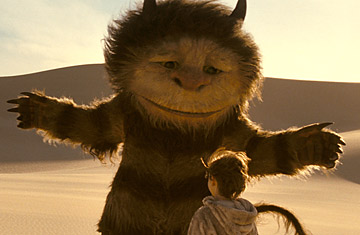
Carol (voice by James Gandolfini) and Max (Max Records) in the Spike Jonze film Where the Wild Things Are
The 338-word story of max--last name unknown, emotional state tumultuous, willingness to obey dubious--has been a bedtime favorite of wild things everywhere (and their parents) since not long after its 1963 publication. That makes nearly five decades' worth of fans, many of whom have been harboring the disquieting fear that the universality of Maurice Sendak's Max, who so exquisitely embodies the inherent storminess of all small beings, would be marred by Spike Jonze's cinematic adaptation of Where the Wild Things Are.
This is a reasonable qualm, but as Max might say, "Now stop!" Jonze, chronicler of uncertain adulthood in Being John Malkovich and Adaptation, has done a masterly job of bringing Sendak's work to the screen. He has broken one Hollywood doctrine: the notion that children's cinema is best devised for miniature couch potatoes who require a steady stream of laughs, action sequences and references to flatulence. Even the best American children's movies, like those made by Pixar, embed their heartfelt messages in what are fundamentally entertainments. The mysterious emotional turmoil and, let's face it, weirdness that every parent deals with on a daily basis can be found in the films of the great Japanese director Hayao Miyazaki but seem to have been deemed off-limits in America. The beauty of Where the Wild Things Are is that for all its fantastical elements, it's a work of realism, an exploration of mood and emotion. Like Sendak's book, which on initial publication was considered too edgy and creepy by some critics and libraries, the movie is dark, but it is perhaps even more richly cathartic.
What makes Sendak's book so compelling is its grounding effect: Max has a tantrum and in a flight of fancy visits his wild side, but he is pulled back by a belief in parental love to a supper "still hot," balancing the seesaw of fear and comfort. In expanding the story, Jonze (with co-writer Dave Eggers) invents just enough of Max's home life to convey the forces behind his disobedience. The parents of 9-year-old Max (played by Max Records, whose name and performance suggest he was born for this role) have split up, and his mother (the gloriously sensitive Catherine Keener) is struggling to keep their household together while trying to meet her own needs. (She has a new boyfriend, played by Mark Ruffalo.) Max also has a sister, a teenager named Claire (Pepita Emmerichs), whose desire to move on from childhood--illustrated in swift, vivid brushstrokes--leaves him lonely and bewildered. Not since You Can Count on Me has the potential for heartbreak in sibling love been rendered so eloquently.
We also glimpse Max at school, where, slumped over in classic bored-boy pose, he hears from his teacher that the sun, like all other things, will die. As Max's eyes widen almost imperceptibly, we realize that he is paying attention and is horrified. Jonze keeps the moment quiet, but it is one more piece in the puzzle of existential angst that drives Max to that fateful eruption with his mother. Here, instead of being sent to his room, he flees the house and goes racing through the neighborhood, baying like a wolf. He finds a boat and sets sail, finally arriving in the land of the wild things.
